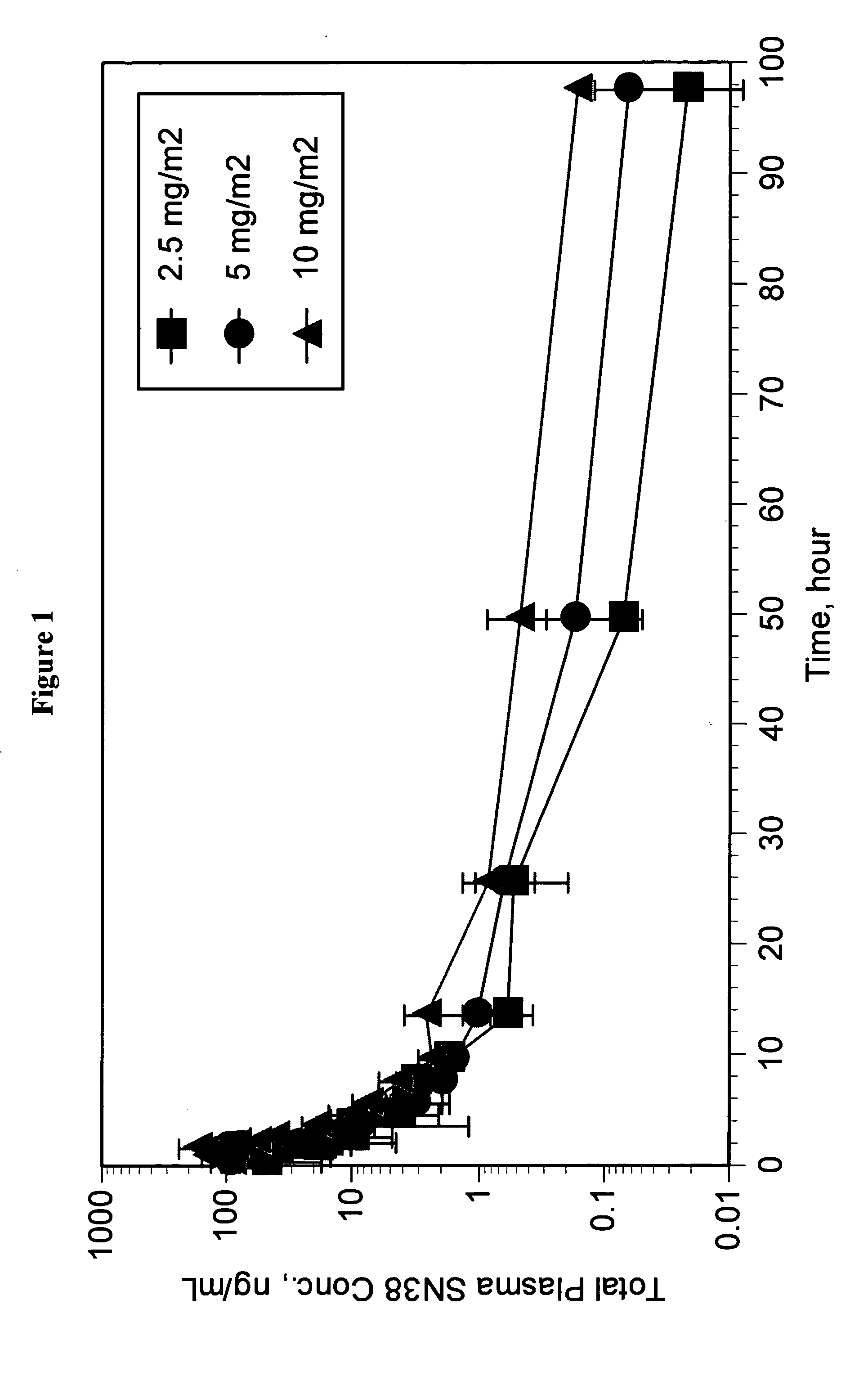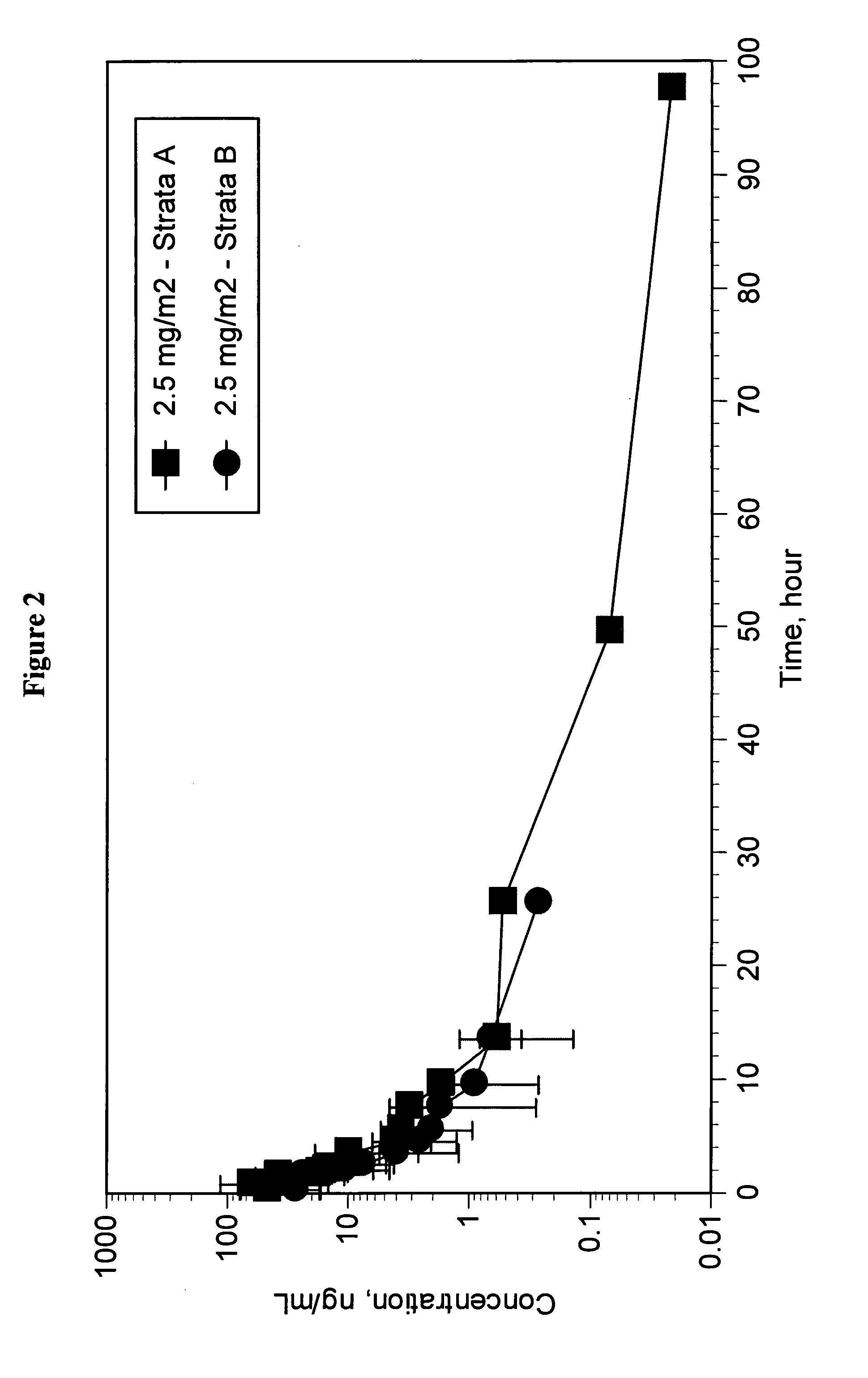Pharmaceutically active lipid based formulation of SN-38
a technology of sn38 and lipids, which is applied in the field of complexes of sn38 with lipids, can solve the problems of insufficient repair of breakage, interference with the use of sn38 as a therapeutic, and cytotoxicity in mammalian cells, and achieve the effect of stable pharmaceutical formulation and convenient administration to mammals
- Summary
- Abstract
- Description
- Claims
- Application Information
AI Technical Summary
Problems solved by technology
Method used
Image
Examples
example 1
[0052] SN38 (3 μmoles) can be dissolved in chloroform containing 3 μmoles cardiolipin. To this mixture, 14 μmoles of phosphatidyl choline dissolved in hexane and 10 μmoles cholesterol in chloroform can be added. The mixture can be stirred gently and the solvents can be evaporated under vacuum at below 30° C. to form a thin dry film of lipid and drug. Liposomes can then be formed by adding 2.5 ml of saline solution and aggressively mixing the components by vortexing. The flasks can then be vortexed to provide multilamellar liposomes and optionally sonicated in a sonicator to provide small unilamellar liposomes. The efficiency of SN38 encapsulation can be determined by dialyzing an aliquot of the subject liposomes overnight in a suitable aqueous solvent or centrifuging an aliquot of the subject liposomes at 200,000×g. for 2 hour at 4° C. Thereafter the liposome fraction is dissolved in methanol and analyzed by standard methods using high pressure liquid chromatography (HPLC), such as ...
example 2
[0053] Similar experimental conditions can be utilized with varying quantities of drug and lipid. For example, concentrations of 6 μM SN38, 6 μM cardiolipin, 28 μM phosphatidyl choline and 20 μM cholesterol can be used by dissolving them in a suitable solvent, evaporating the solvent, and dispersing the dried lipid / drug film in a suitable aqueous solvent such as 5 ml of 7% trehalose-saline solution. Hydration of the liposomes can be facilitated by vortexing and / or sonicating the mixture. The liposomes can then be dialyzed, as desired, and the percent encapsulation of SN38 in liposomes measured, as described above. Typically, SN38 encapsulation will be greater than about 75% and more generally between about 85 to 95% or more as assayed by HPLC.
example 3
[0054] SN38 can be encapsulated in liposomes by using 3 μM of the drug, 15 μM of dipalmitoyl phosphatidyl choline, 1 μM cardiolipin, and 9 μM cholesterol in a volume of 2.5 ml. The drug and lipid mixture can be evaporated under vacuum and resuspended in an equal volume of saline solution. The remainder of the process can be similar to that described above. The SN38 encapsulation efficiency will generally be higher than 75% in this system.
PUM
| Property | Measurement | Unit |
|---|---|---|
| concentration | aaaaa | aaaaa |
| concentration | aaaaa | aaaaa |
| concentration | aaaaa | aaaaa |
Abstract
Description
Claims
Application Information
 Login to View More
Login to View More - R&D
- Intellectual Property
- Life Sciences
- Materials
- Tech Scout
- Unparalleled Data Quality
- Higher Quality Content
- 60% Fewer Hallucinations
Browse by: Latest US Patents, China's latest patents, Technical Efficacy Thesaurus, Application Domain, Technology Topic, Popular Technical Reports.
© 2025 PatSnap. All rights reserved.Legal|Privacy policy|Modern Slavery Act Transparency Statement|Sitemap|About US| Contact US: help@patsnap.com



